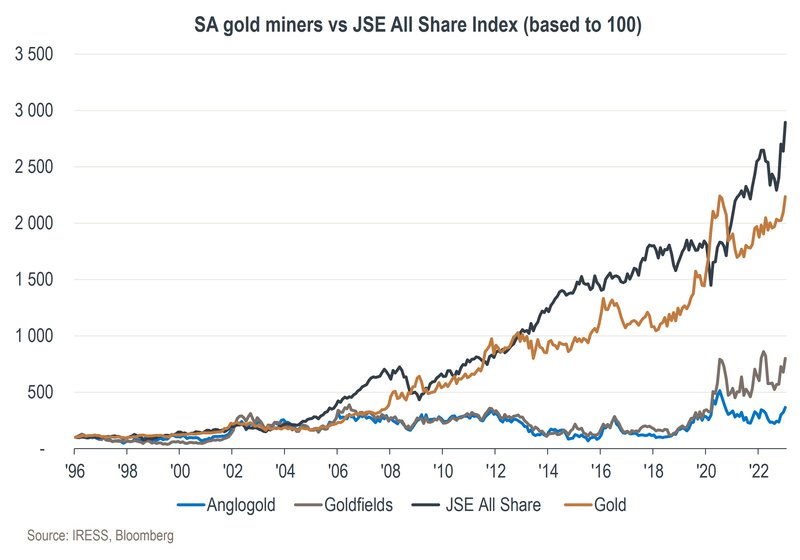Stay abreast of COVID-19 information and developments here
Provided by the South African National Department of Health
SHOULD YOU GO FOR GOLD
IN YOUR PORTFOLIO?
Views on whether to include gold in an investment portfolio tend to be highly polarised – investors seem to either love it or fail to see the investment merits of the precious yellow metal. In our view, owning gold can be highly lucrative in an equity portfolio context – in times of crisis, it can provide valuable currency when other shares are cheap.
Gold tends to do well in an environment in which other risky assets struggle, but it performs poorly in times of economic expansion and increased risk appetite. One typically wants to own it when you expect real interest rates to decline (when you think central banks will start cutting interest rates or inflation will rise significantly while global growth slows – the so-called stagflation seen in the 1970s). Conversely, you need to be wary of gold investments when you expect interest rates to increase while inflation remains under control – this is typically when gold’s outlook relative to other asset classes doesn’t look too promising.
If you’re going for gold in your portfolio, the question arises as to which of gold shares or physical gold is the better choice. As is to be expected, gold equities have a strong correlation with gold prices (over the past decade, Goldfields and AngloGold Ashanti have shown a correlation coefficient of >0.7 to the rand gold price) and should therefore do well when gold prices rise. So as a starting point, the merits of gold shares are similar to those of physical gold – they tend to do well in an environment in which other risky assets perform poorly.
However, over the past few decades, gold shares have significantly underperformed both physical gold and the JSE All Share Index (ALSI) on a cumulative basis. From 1996, assuming dividends were reinvested, the ALSI returned 13% and the rand gold price 12% per annum, while Goldfields and AngloGold returned just 8% and 5% respectively. As can be seen on the chart below, R10 000 invested in 1996 in the ALSI would have yielded R289 500 today, compared to R223 500 for physical gold, R80 100 for Goldfields and R36 600 for AngloGold.

Gold company management teams globally have, on average, not been good allocators of capital. South African listed shares have also been faced with ageing and ever-deepening local mines, leading to company profits largely being spent on diversifying offshore while paying very low cash returns to shareholders. This has therefore not been an investment you wanted to own through the cycle – if you managed to make money from gold shares you needed to have traded them very well, as illustrated on the chart.
What is clear, however, is that there are certain times (for example, in 2008/09 and 2019/20) when owning gold equities can be very lucrative in an equity portfolio context. As we’ve mentioned, like physical gold, gold equities tend to perform well during a crisis when other shares don’t, providing valuable currency at a time when other shares are cheap.
After not owning gold shares for more than a decade, we decided to initiate a position in mid-2022, as we felt the macro backdrop presented several scenarios in which gold and gold shares could potentially do very well. The major risks were an inflation spiral where the US Federal Reserve (the Fed) did not have the ability or willingness to bring inflation under control as the economy weakened, or a large escalation in geopolitical tensions. In addition, we believed that the price of gold as insurance was at that stage not excessive – it was priced in line with the expectation for forward-looking real interest rates, and South African gold equities were trading on single-digit multiples.
Our preference was, and still is, for AngloGold Ashanti. Its large JSE-listed peer, Goldfields, had performed much better operationally over the preceding three years – it outperformed AngloGold by more than 100%. The latter had also been experiencing a leadership vacuum but found a credible CEO in the Colombian Alberto Calderon, with a clear strategy to improve the performance of the company’s mines. We were therefore of the view that there was ample room to catch up to Goldfields, off a low base.
AngloGold’s performance since then has surprised to the upside. At the time of writing, the company has rallied by more than 50% compared to the market’s 20% and rand gold prices’ 12%. This has led us to take profits, as we feel the cost of owning gold shares (insurance) has increased too much. In addition, with inflation cooling across the globe, the likelihood of stagflation (the real bull case for owning gold and gold shares) appears to have declined quite significantly.
Despite taking profits, we do, however, maintain a small weight in AngloGold, as there are still a few macro scenarios that could lead to an outcome where gold does even better. Most notably, we could yet see an escalation in geopolitical tensions or a severe global recession, which would force the Fed to change course and to start cutting interest rates. In these scenarios, we still see meaningful upside in the gold price and in gold shares.
Your wealth plan is designed with you in mind. Your financial reality, aspirations and risk profile.
Carl Schoeman has spent 22 years in Investment Management.

Looking for a customised wealth plan? Leave your details and we’ll be in touch.
South Africa
South Africa Home Sanlam Investments Sanlam Private Wealth Glacier by Sanlam Sanlam BlueStarRest of Africa
Sanlam Namibia Sanlam Mozambique Sanlam Tanzania Sanlam Uganda Sanlam Swaziland Sanlam Kenya Sanlam Zambia Sanlam Private Wealth MauritiusGlobal
Global Investment SolutionsCopyright 2019 | All Rights Reserved by Sanlam Private Wealth | Terms of Use | Privacy Policy | Financial Advisory and Intermediary Services Act (FAIS) | Principles and Practices of Financial Management (PPFM). | Promotion of Access to Information Act (PAIA) | Conflicts of Interest Policy | Privacy Statement
Sanlam Private Wealth (Pty) Ltd, registration number 2000/023234/07, is a licensed Financial Services Provider (FSP 37473), a registered Credit Provider (NCRCP1867) and a member of the Johannesburg Stock Exchange (‘SPW’).
MANDATORY DISCLOSURE
All reasonable steps have been taken to ensure that the information on this website is accurate. The information does not constitute financial advice as contemplated in terms of FAIS. Professional financial advice should always be sought before making an investment decision.
INVESTMENT PORTFOLIOS
Participation in Sanlam Private Wealth Portfolios is a medium to long-term investment. The value of portfolios is subject to fluctuation and past performance is not a guide to future performance. Calculations are based on a lump sum investment with gross income reinvested on the ex-dividend date. The net of fee calculation assumes a 1.15% annual management charge and total trading costs of 1% (both inclusive of VAT) on the actual portfolio turnover. Actual investment performance will differ based on the fees applicable, the actual investment date and the date of reinvestment of income. A schedule of fees and maximum commissions is available upon request.
COLLECTIVE INVESTMENT SCHEMES
The Sanlam Group is a full member of the Association for Savings and Investment SA. Collective investment schemes are generally medium to long-term investments. Past performance is not a guide to future performance, and the value of investments / units / unit trusts may go down as well as up. A schedule of fees and charges and maximum commissions is available on request from the manager, Sanlam Collective Investments (RF) Pty Ltd, a registered and approved manager in collective investment schemes in securities (‘Manager’).
Collective investments are traded at ruling prices and can engage in borrowing and scrip lending. The manager does not provide any guarantee either with respect to the capital or the return of a portfolio. Collective investments are calculated on a net asset value basis, which is the total market value of all assets in a portfolio including any income accruals and less any deductible expenses such as audit fees, brokerage and service fees. Actual investment performance of a portfolio and an investor will differ depending on the initial fees applicable, the actual investment date, date of reinvestment of income and dividend withholding tax. Forward pricing is used.
The performance of portfolios depend on the underlying assets and variable market factors. Performance is based on NAV to NAV calculations with income reinvestments done on the ex-dividend date. Portfolios may invest in other unit trusts which levy their own fees and may result is a higher fee structure for Sanlam Private Wealth’s portfolios.
All portfolio options presented are approved collective investment schemes in terms of Collective Investment Schemes Control Act, No. 45 of 2002. Funds may from time to time invest in foreign countries and may have risks regarding liquidity, the repatriation of funds, political and macroeconomic situations, foreign exchange, tax, settlement, and the availability of information. The manager may close any portfolio to new investors in order to ensure efficient management according to applicable mandates.
The management of portfolios may be outsourced to financial services providers authorised in terms of FAIS.
TREATING CUSTOMERS FAIRLY (TCF)
As a business, Sanlam Private Wealth is committed to the principles of TCF, practicing a specific business philosophy that is based on client-centricity and treating customers fairly. Clients can be confident that TCF is central to what Sanlam Private Wealth does and can be reassured that Sanlam Private Wealth has a holistic wealth management product offering that is tailored to clients’ needs, and service that is of a professional standard.